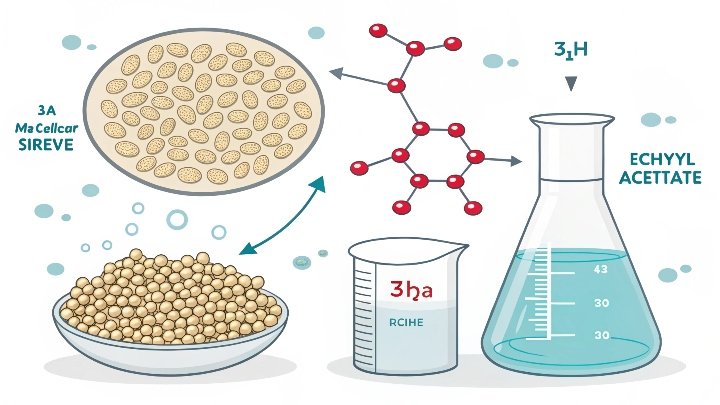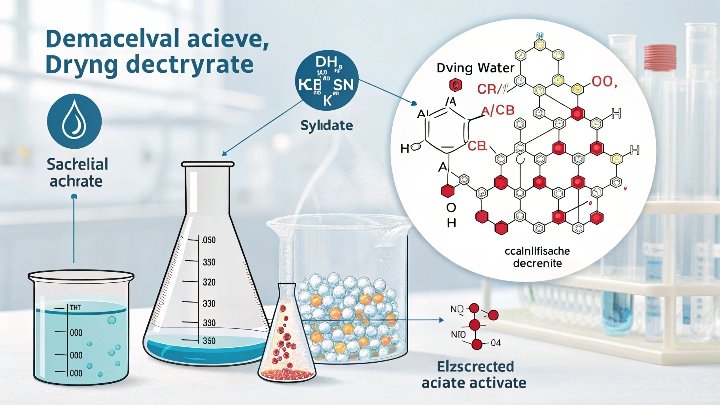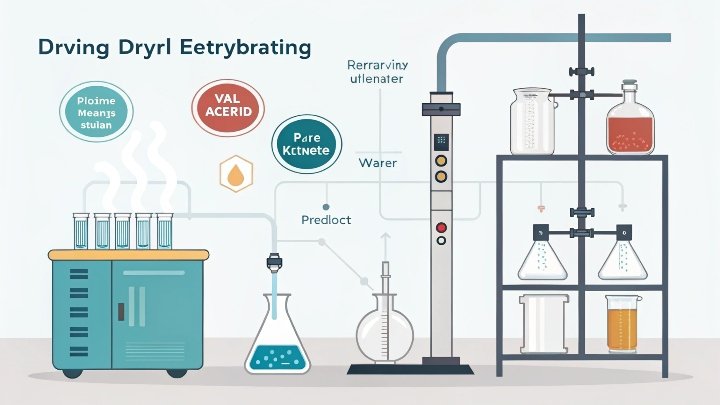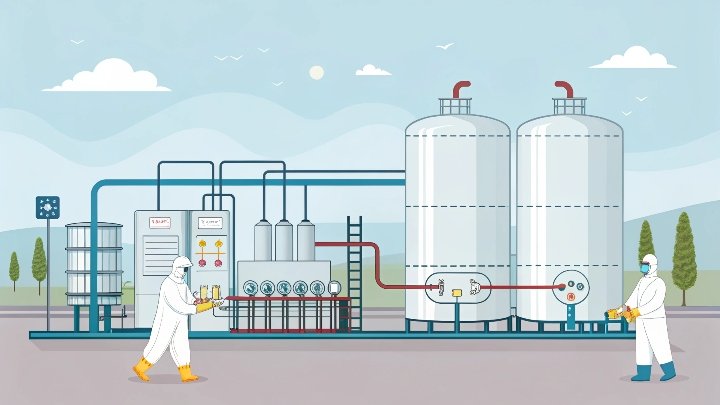I once faced unstoppable frustration with watery ethyl acetate. My product quality suffered. I found a proven fix that changed everything.
The best molecular sieve for drying ethyl acetate is 4A. It removes moisture swiftly while keeping raw materials intact. This leads to higher purity and efficient production. Its uniform pores filter out water without altering ethyl acetate. That helps produce top-quality products with minimal effort.
Let me explain how molecular sieves solve dehydration problems. I'll walk you through the types and tips for perfect results.
What Makes Molecular Sieves the Ultimate Drying Superstars?
I once wrestled with slow, inefficient drying methods. I needed a better way. Molecular sieves promised power and ease, so I gave them a try.
Molecular sieves excel because they selectively trap water molecules. They have uniform pores that let them capture moisture while leaving bigger molecules alone. That means fast, targeted dehydration. They're also reusable and easy to handle, which saves time and money.
Why Molecular Sieves Lead the Way
Molecular sieves are a type of synthetic zeolite with microscopic pores of precise sizes. These tiny channels allow them to trap small molecules, like water, while letting larger molecules pass. This structure comes from a crystalline aluminosilicate framework. It remains stable under normal operating conditions. When I first researched them, I realized they offered a targeted approach to removing water from liquid mixtures.
I used to rely on simple distillation for dehydration. But water’s low boiling point combined with constant azeotrope formations made that method unreliable. Molecular sieves offered a consistent and effective way to tackle water content. Their selective adsorption is powered by physical forces inside the pore structure. That means water molecules slip into the pores, get held there, and stay out of my product.
Another advantage is that molecular sieves do not produce pollutants. They do not react with ethyl acetate. They do not introduce new chemicals into the mix. They simply remove moisture. This preserves product composition, which is crucial if I want to keep ethyl acetate’s chemical properties intact. With distillation or other techniques, I risk partial decomposition or energy-intensive steps. But with molecular sieves, I can minimize process complications.
Molecular sieves also help me save time and money. They have high adsorption capacity, which means a small volume of sieves can remove a significant amount of water. Plus, they can be regenerated. After saturation, I can heat them or reduce pressure, and they release the trapped water. Then I can reuse them. This regeneration feature helps me reduce operating costs over the long term.
Below is a quick overview of some key features that make molecular sieves the top choice for drying:
| Feature | Benefit |
|---|---|
| Uniform pore size | Selective water capture |
| High adsorption | Removes large amounts of moisture |
| Regeneration option | Cost-effective and reusable |
| Chemical stability | Preserves ethyl acetate purity |
These features show why molecular sieves have earned their reputation. They make dehydration straightforward, reliable, and cost-effective. I find them essential whenever I need moisture-free solvents like ethyl acetate.
Type 3A vs. Type 4A: Which Sieve Steals the Show for Ethyl Acetate?
I once spent days comparing different pore sizes. I wanted the sieve that removed water but left my main product untouched. I finally narrowed it down.
Type 3A and Type 4A differ in pore size. Type 3A has a smaller pore diameter that excludes bigger molecules such as ethanol. Type 4A, with its slightly larger pores, is more common for ethyl acetate dehydration. It balances capacity and efficiency without harming the solvent.
Knowing Which Sieve Fits Your Process
When I needed to dry ethyl acetate, I learned that 3A and 4A sieves share many traits. Both can adsorb water, both use similar crystalline structures, and both handle many dehydration tasks. However, their pore sizes differ slightly. A 3A sieve has pores around 3 angstroms, and a 4A sieve has pores around 4 angstroms. This tiny difference changes what each sieve captures best.
3A can handle water but leaves molecules like ethanol and certain other components untouched. This can be important if you fear losing smaller molecules that might slip into bigger pores. For ethyl acetate, though, 4A is often recommended because of the presence of water, ethanol, and other low-boiling impurities. Ethanol can form azeotropes with ethyl acetate, so a robust sieve with an appropriate pore size helps remove water quickly.
I also noticed that Type 4A often comes with a higher total adsorption capacity. This means it can grab and hold more water before it needs regeneration. That higher capacity saves me time, since I do not have to switch or regenerate the sieves as often. And since 4A is widely used, it is easy to source at a reasonable cost.
Below is a quick comparison:
| Sieve Type | Pore Size | Best Use Cases | Key Benefits |
|---|---|---|---|
| 3A | ~3Å | Drying solvents with small molecules | Lower risk of adsorbing ethanol |
| 4A | ~4Å | Ethyl acetate, general-purpose drying | Large capacity, flexible adsorption |
In my experience, if I want to remove water from ethyl acetate without adding complexity, Type 4A is the ideal pick. It is powerful enough to handle water content while keeping the essential solvent composition intact. If my process has extremely sensitive components that might be small enough to enter the 4A pores, I might reconsider 3A. But for typical ethyl acetate dehydration, 4A does the job well.
I like 4A because it strikes a good balance. It is precise enough to capture water but not so restrictive that I lose out on bigger solvent molecules. That ensures I get the purity I need. It also means fewer maintenance headaches. I find it to be a dependable solution whenever I need a stable, contamination-free process.
Pro Tips: How to Use Molecular Sieves for Flawless Ethyl Acetate Dehydration
I remember the first time I used molecular sieves. I tossed them into the process without a plan. The result was okay but not perfect. Then I learned a few tricks.
To get the best results, choose the right pore size, pre-dry your sieve if possible, and maintain the correct contact time. Also, keep an eye on temperature and regeneration schedules. That ensures consistent performance and minimal waste.
Best Practices for Seamless Drying
Using molecular sieves involves more than just dumping them into a container. I learned that factors like contact time, temperature, and the initial water content all matter. I also realized that if the sieve is not activated, it will not adsorb moisture effectively. Activation typically involves heating the sieve to drive off any residual water. Once activated, it is ready to adsorb new moisture from your ethyl acetate.
Another step is to figure out the right ratio of sieve to solvent. If I do not use enough sieve material, it will saturate too quickly and leave water behind. If I use too much, I may waste resources. Experimentation or pilot testing helps me determine the optimal ratio. I also consider the feed’s water content. The higher the moisture level, the more sieve I need, or the more often I must replace or regenerate it.
Temperature plays a major role in water adsorption. Typically, molecular sieves work well at ambient or moderate temperatures. However, if the temperature gets too high, the sieve might release water prematurely. That reduces efficiency. On the flip side, if it is too cold, diffusion can slow, making adsorption less effective. Balancing temperature ensures the best results.
Flow rate or agitation also matters. If I run the solvent through a column filled with sieves, the contact time must be sufficient for water molecules to migrate into the pores. If I do a batch process in a stirred tank, I need enough mixing time for good contact. I also must watch for sieve attrition. If the beads break down, dust or fines can contaminate the product or hinder flow.
Below is a short checklist to keep things running smoothly:
| Step | Action |
|---|---|
| Activation | Heat the sieves to remove stored moisture |
| Proper dosage | Use enough sieve to handle your water load |
| Temperature control | Keep moderate temperatures for best adsorption |
| Contact time | Ensure enough mixing or flow for full contact |
| Regeneration cycle | Heat or pressure-swing to remove water |
Regeneration is a crucial aspect. Once the sieves become saturated with water, they lose their capacity to dry further. Heating them to 200–300°C (depending on the sieve type) drives out the adsorbed water. Then you can cool them in a dry environment before reusing them. This process allows you to maximize your investment and keep the system efficient.
I have found that consistent monitoring is key. I check water content in the output periodically to see if the sieve bed is reaching capacity. When I notice a spike in water levels, that is my cue to schedule a regeneration cycle. By following these steps, I keep my ethyl acetate pure and my production process stable.
Conclusion
Molecular sieves offer a simple, effective way to dry ethyl acetate. I rely on 4A for top results.






